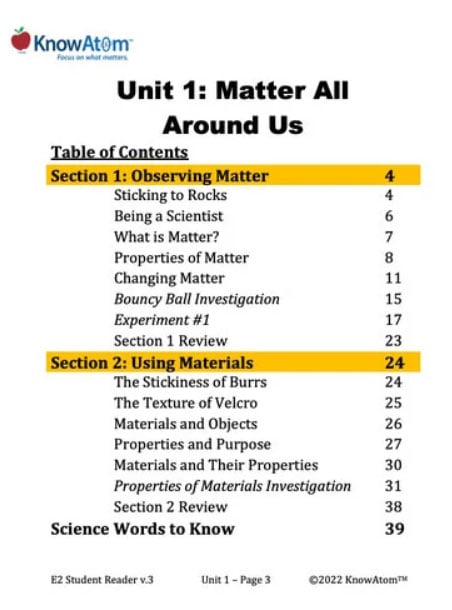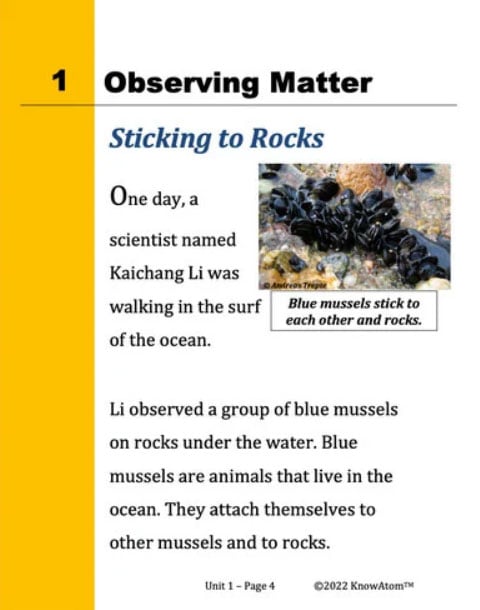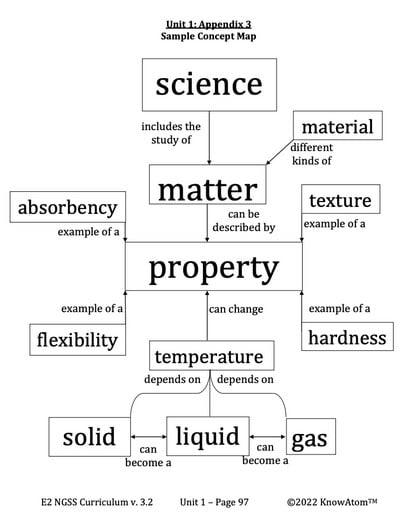Students are introduced to matter by investigating the properties of bouncy balls they make. Students then conduct an experiment with their bouncy balls to explore how temperature can affect the properties of materials.
In 2nd grade, students conduct investigations, carry out experiments, and apply their scientific knowledge to engineer prototype solutions. In this unit, students investigate the science phenomenon of properties of different kinds of matter, connecting a material’s properties with the functions for which it is used.
In this first lesson of the unit, students are introduced to matter’s properties as they describe the properties of the materials that make up a bouncy ball they create before and after they are combined. Students then use their bouncy balls to conduct an experiment that explores how the temperature of the ball affects its properties, specifically its bounce height. This page highlights each component of the curriculum offered for this lesson.
This background information helps teachers explore the phenomenon being studied in this unit on a deeper level.
Li is a scientist because he uses a scientific process to discover knowledge that answers questions. The two most important tools scientists use are observation and experimentation.
An observation is information gained through the senses. It can produce qualitative (non-numerical) or quantitative (numerical) data. For example, Li made the qualitative observation that blue mussels were able to remain attached to the slippery rocks even as powerful waves crashed into them.
An experiment is a specific procedure that tests if a hypothesis is true or false. A hypothesis is a statement that can be proved true or false. Scientists test their hypotheses by designing experiments, and use data from their experiment to determine whether their hypothesis was true or false.
Li’s experiments focused on the properties of the substance produced by the mussels that allowed them to attach so firmly to the rocks.
A property is an observable or measurable characteristic of matter. The word matter refers to all of the “stuff” in our universe. In scientific terms, matter is everything that has mass and takes up space. Atoms are tiny particles that make up matter. Forms of energy such as light and heat are not matter, but they do affect matter.
There are 118 known elements or types of atoms, and there are many different ways that atoms can join together. This is why there is such a wide diversity of matter in the universe. Blue mussels are made of matter, as is the adhesive the blue mussels make, the ocean water the mussels live in, and the air around the ocean. Stars, planets, humans, trees, and rocks are also all made up of different kinds of matter.
Students are introduced to matter by investigating the properties of bouncy balls they make. Students then conduct an experiment with their bouncy balls to explore how temperature can affect the properties of materials.

Prepared hands-on materials, full year grade-specific curriculum, and personalized live professional development designed to support mastery of current state science standards.
Absorbency : the ability of a solid material to soak up a liquid
Flexibility: the ability of a solid material to bend easily without breaking
Gas: matter that has no shape and spreads out, completely filling its container
Hardness: the ability of a solid material to keep its shape when an outside force is applied
Liquid: matter that takes the shape of its container but has no shape of its own
Material: any kind of matter that makes up objects
Matter: everything that is made up of atoms and takes up space; includes all of the solids, liquids, and gasses around us
Property: an observable or measurable characteristic of matter
Science: all knowledge learned from experiments
Solid: matter that holds its own shape until something changes it by force
Temperature: a measure of heat
Texture: – the way a material or object feels

Being A Scientist
Li took some mussels to his lab to study. He wanted to find the answer to a question: What material do mussels make that allows them to stick to rocks so well?
Li first did some research. Scientists know that blue mussels make their own kind of glue. Unlike most other glues, it works well in the water. It is so strong that the mussels stay put even when waves crash into them.
What is Matter?
Li studied the properties of the blue mussel’s glue. A property is an observable or measurable characteristic of matter.
Matter is what makes up all things. All matter is made up of tiny parts that are too small to be seen. These parts are called atoms. Blue mussels are made of matter. The glue the blue mussels make is also made of matter. Ocean water is made of matter. The air you breathe is made of matter.


Properties of Matter
There are many different kinds of properties. The ability to stick to different surfaces is one property. Another property is whether matter is a solid, a liquid, or a gas at a particular temperature. For example, wet glue is a liquid. A liquid has no shape of its own. It takes the shape of its container. It also flows. Some liquids are thick. They flow slowly. Other liquids are thin. They flow quickly.
Glue is a liquid until it dries. Then it turns into a solid. Solids are the only kind of matter with a shape of their own. They hold their shape until something changes them by force.
Like liquids, solids have different properties. Color is one property. Texture is another property. It describes the way a material or object feels. Some materials have a rough texture. Some materials have a soft texture. And some materials have a smooth or rubbery texture.
Students conduct an experiment to see how cooling their bouncy ball in a freezer changes the properties of the ball, affecting how high the ball can bounce. They use their data to construct an argument about the difference between reversible and irreversible changes to matter. Students are also introduced to cause-and- effect relationships as they investigate how the height that their ball can bounce is affected by its temperature.
KnowAtom incorporates formative and summative assessments designed to make students thinking visible for deeper student-centered learning.

Standards citation: NGSS Lead States. 2013. Next Generation Science Standards: For States, By States. Washington, DC: The National Academies Press. Neither WestEd nor the lead states and partners that developed the Next Generation Science Standards were involved in the production of this product, and do not endorse it.
